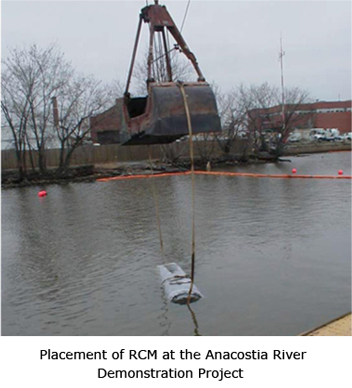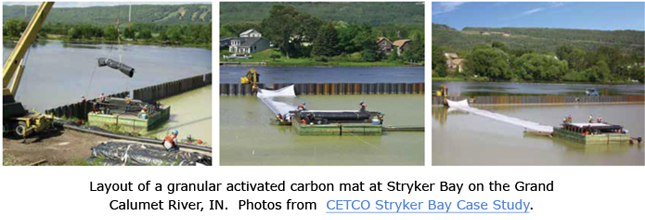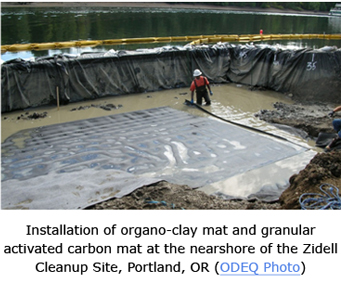
|
REACTIVE CAP MATS
Permeable composite mats of GAC (or other reactive amendments) placed within geotextiles are referred to as Reactive Cap Mats (RCM) or Reactive Core Mats. RCMs are especially useful at sites where a thin cap is required that also affords erosion resistance, groundwater upwelling reduction, chemical isolation, and/or slope stability (USEPA 2013, ITRC 2014). RCMs are frequently placed on the contaminated sediment, and then secured with a layer of sand and/or larger rock for hydraulic stability or habitat requirements.
|
|
Site |
Contaminant |
Project Description |
Delivery Methods |
Project Web Link |
|
Naval Air Station, Cottonwood
Bay, Dallas TX |
PCBs, PAHs, chromium, lead |
Small-scale pilot project that tested RCM with 0.28 lb/ft2 activated carbon, 0.23 lb/ft2
apatite, 0.28 lb/ft2 organoclay in AOS 80 geotextile. |
Prototype reactive mats rolled up and deployed
from a john-boat by divers. Divers
secured the mats in the shallow bay with anchors, anchor screws, and blocks. Some of the treatments were further covered
with sand. |
|
|
St. Louis River Superfund
Site |
NAPL/PAHs |
11 acres of cap that included a
reactive core mat with GAC to absorb advected PAH-porewater during
consolidation. The cross section of the cap was 0.5 ft (15 cm) sand/activated
carbon mat/2.5 ft (75 cm) sand. |
Reactive mats attached to outer
sheet-pile wall and unrolled toward shore from a moveable barge. Overlapping RCMs stapled and allowed to
sink, followed by sand placement |
|
|
Zidell Marine Cleanup Site |
NAPL/PAHs/PCBs |
The majority of the cap (12 acres) is a sand cap, consisting of material
obtained from the Columbia River that was tested and determined to be clean.
A low-profile cap was placed over a 1 acre area that
consisted of a reactive core mat (RCM) with activated carbon and apatite to
limit contaminant movement. The RCM
was covered with armored with rock to protect it from erosion |
Construction of the low profile cap was completed by a dive team working in
concert with a crane derrick to first lower RCM panels into place, and
subsequently adjust the placement to meet overlap requirements. |
|
|
Anacostia River, Washington,
DC |
PCBs, PAHs, chromium, lead |
1100 m2 area was capped
with a coke-filled RCM and covered with 15 cm of sand. |
Twelve 3.1 m x 31 m coke-filled
RCMs were placed
with a 0.3 m overlap using a crane with a clamshell.A
diver followed the unrolling mat to insure proper placement. A sand layer (~15 cm) |
|
|
One of the earliest demonstrations for the use of activated carbon as part of an RCM occurred as part of the 2004 Anacostia River Active Capping demonstration project (McDonough et al, 2006). An 1,100 m2 area of PCB-contaminated sediment was capped with a coke-filled RCM and covered with 15 cm layer of sand. Subsequent analysis for PAHs above the coke breeze mat-amended cap demonstrated that the cap was effective in isolating the contaminants (USEPA 2013).
|

|




